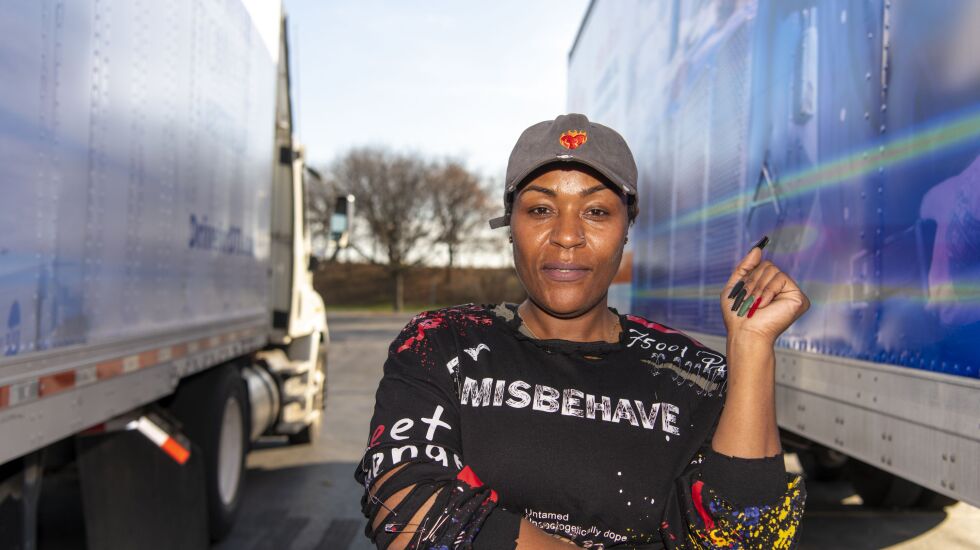
In 2008, Maggie Selagea and her husband lost their construction business, worth millions, to the economic meltdown.
“When the economy crashed, we fell flat on our face,” Selagea said. She and her husband realized they needed to find “something that was not going to be affected so much by the economy.”
Selagea said she found that more stable industry in transportation — specifically, trucking.
“Everything in this world needs transportation,” Selagea said. “People commute in order to survive. If this industry stops, that means that the world will stop.”
In 2008, Selagea said, she became a supervisor for Mega Load, a car carrier company. It’s based in Chicago but transports across the U.S.
Selagea is just one of the thousands of women who have joined the industry over the past two decades when the number of female drivers increased by 80%.
In 1999, there were about 3.1 million truck drivers and 4.9%, or 152,684, were women. In 2021, there were nearly 3.5 million truck drivers and 7.9%, or 275,473, were women, according to the Department of Labor.
At Mega Load, Selagea supervises six drivers and a fleet of nine trucks. When she’s short-staffed, Selagea gets behind the wheel.
“I grew up with nine brothers, so I’m a car fanatic,” she said. “I truly handle them with care, and I expect the same from everyone we work with.”
Selagea’s heightened sense of care for her product and equipment says something about how women are changing the industry — even though, for now, they are paid less. On average, male truck drivers make about $61,000 while their female counterparts make about $52,000.

Rhonda Hartman, a truck driver based in Iowa and a member of Women in Motion — an American Trucking Association initiative to recruit women to join the field — said the organization has found female drivers operate more safely and take better care of their equipment than their male counterparts. Women are less likely to get tickets and less likely to be in accidents, lowering litigation costs and insurance fees for freight companies, Hartman said.
The 2022 Women in Trucking Index — an annual analysis of women’s roles in the transportation industry — reflects Hartman’s sentiment.
“[Women are] typically less likely to take risks and therefore can be safer drivers than men,” the WIT index said. “In addition, women generally possess strong multitasking and organizational skills, they are strong communicators, and they usually are patient, focused and reliable.”
Matt Hart, executive director of the Illinois Trucking Association, agreed with Hartman and said there’s a shortage of drivers nationwide. The ITA is trying to recruit more women, according to Hart, saying they tend to be more “risk-averse.”
Hart said the American Trucking Association — of which the ITA is a member— has been recruiting female drivers through campaigns and events led by current female drivers who form “road teams,” one of which Hartman is on. To be picked for a road team, members must have exemplary driving records and strong communication skills, Hart said.
Hartman has visited the White House to talk with President Joe Biden, regularly teaches driver’s education classes and travels nationwide to speak on panels of female drivers.
“We have the road team captains that we’ve hosted several times in Illinois to talk about the females driving in this industry,” Hart said about members like Hartman.
Hart said while the technology itself has not changed because of women, more trucks are being equipped with automatic transmissions, which can make driving less physically demanding and more accessible to women.
Selagea, in the industry for 15 years, and Hartman, working in it for 40, both said they’re happy to see more female drivers.
“As a whole, to have women involved, it becomes a nicer industry to work in,” Hartman said.
That soon could include Cornilla Johnson. The Chicago native, a student for All Pro Truck School, is finishing three months of training in how to drive Class A vehicles, such as 18-wheelers. Johnson, a single mother to two boys, said she grew up around family involved in the trucking industry, and now it’s a way to show her sons what they’re capable of.
Johnson said she loves the flexible schedule — and hopes it allows her to visit her boys once they go off to college.
“Trucking was always one of my goals,” Johnson said. “It’s like an egg I’m trying to hatch.”
Johnson said being a truck driver has given her more confidence in herself as she’s had to prove to others that she knows how to do the job and has had to handle backlash due to her gender.
“It can be an uncomfortable situation when so many men are out,” Johnson said. “Be confident in what you’re doing and who you are. As a woman, you can definitely get through it.”







